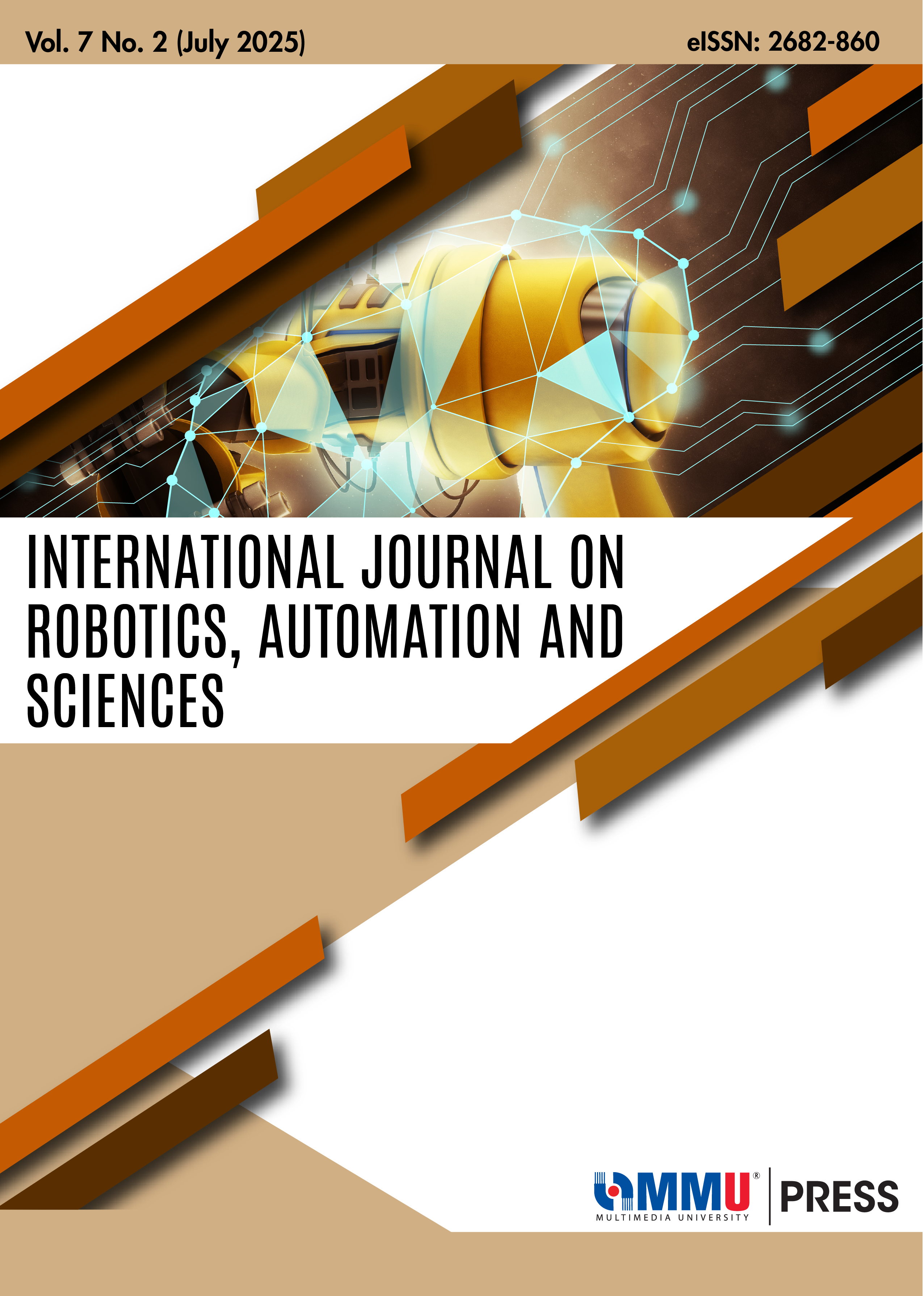Numerical Integration Approach for Nonlinear Differential Equation in Growth Modelling
Main Article Content
Abstract
The nonlinear ordinary differential equation (ODE) is a common mathematical model for real-world problems. However, its analytical solution is hard to find and may not exist due to the nonlinear and complex structures. Thus, an approximate method is usually employed in mathematical modelling to obtain its solution. This study applies numerical integration techniques, namely Gaussian quadrature and Simpson’s rule methods, to solve nonlinear ODE, which is a hyperbolic growth model. We first discuss the ODE model and then substitute its exact solution model into the ODE model to obtain the model’s numerical solution using numerical integration approaches. Next, we aim to predict the solution of the nonlinear growth model by proposing two linear models and integrating them iteratively. We introduce a least square optimization problem and derive a set of first-order necessary conditions for estimating the model parameter optimally. A gradient descent method is employed to iterate and update the solution of the linear model. The numerical integration techniques are efficient, while the proposed method has proved to be an alternative approach to handling nonlinear ODEs, especially for a nonlinear growth model, since the optimal linear model solution satisfactorily approximates the growth model solution with a small mean square error value.
Manuscript received:3 Apr 2025 | Revised: 15 May 2025 | Accepted: 22 May 2025 | Published: 30 Jul 2025
Article Details

This work is licensed under a Creative Commons Attribution-NonCommercial-NoDerivatives 4.0 International License.
References
T. Amir, “2.5 Applications of First-Order ODE”, Differential Equations, Canada: eCampus Ontario, 2024.
URL:https://ecampusontario.pressbooks.pub/diffeq/chapter/2-5-applications-of-first-order-ode/
P.J. Olver, “Nonlinear Ordinary Differential Equations,” United States: University of Minnesota, 2022.
URL: https://www-users.cse.umn.edu/~olver/ln_/odq.pdf
G. Sarma and Vezhopalu, “Analytical and Numerical Investigation of Nonlinear Differential Equations: A Comprehensive Study”, Journal of Computational Analysis and Applications (JoCAAA), vol. 34, no.1, pp. 213 – 222, 2025.
URL:https://eudoxuspress.com/index.php/pub/article/view/1742
F.S. Guzmán, “Ordinary Differential Equations”, Numerical Methods for Initial Value Problems in Physics, New York: Springer Cham, pp. 7-97, 2023.
DOI: https://doi.org/10.1007/978-3-031-33556-3
M. Al-Mazmumy, A.A. Alsulami, H.O. Bakodah and N. Alzaid, “Modified Adomian Method Through Efficient Inverse Operators to Solve Nonlinear Initial-Value Problems for Ordinary Differential Equations,” Axioms 2022, vol. 11, no.12, pp. 698-1 – 698-16, 2022.
DOI: https://doi.org/10.3390/axioms11120698
K. A. Koroche, G. K. Mayu, “Adam-Bash forth-Multan Predictor Corrector Method for Solving First Order Initial Value
Problem and its Error Analysis,” Indian Journal of Advanced Mathematics (IJAM), vol. 1, no. 2, pp. 30-40, 2021.
DOI: https://doi.org/10.54105/ijam.B1112.101221
N. Sharma, S. Singh, and D. Kumar, “Numerical Solution of Nonlinear Dual-Phase-Lag Model for Analyzing Heat Transfer in Tissue During Thermal Therapy,” Computational and Mathematical Methods, vol. 3, no. 6, pp. 1-15, 2021.
DOI: https://doi.org/10.1002/cmm4.1183
R. Capuano, N. Vaiana, D. Pellecchia and L. Rosati, “A Solution Algorithm for a Modified Bouc-Wen Model Capable of Simulating Cyclic Softening and Pinching Phenomena,” Internal Federation of Automatic Control, vol. 55, no. 20, pp. 319-324, 2022.
DOI: https://doi.org/10.1016/j.ifacol.2022.09.115
V. Cornells, F. J. Vermolen, M. B. van Gijzen, V. Thea, Numerical Methods for Ordinary Differential Equations, TU Delft OPEN Publishing, 2023.
DOI: https://doi.org/10.5074/t.2023.001
A. Televnoy, S. Ivanov, T. Zudilova, T. Voitiuk, “Neural ODE Machine Learning Method with Embedded Numerical Method,” Conference of Open Innovation Association, FRUCT 2021, pp. 451 – 457, 2021.
DOI: https://doi.org/10.23919/FRUCT50888.2021.9347610
F. A. C. Viana, R. G. Nascimento, A. Dourado, Y. A. Yucesan, “Estimating Model Inadequacy in Ordinary Differential Equations with Physics-Informed Neutral Networks,” Computers & Structures, vol. 245, pp. 1 – 12, 2021.
DOI: https://doi.org/10.1016/j.compstruc.2020.106458
M. K. Jaradat and W. S. Yang, “An Adaptive Time-Stepping Control Algorithm for Molten Salt Reactor Transient Analyses,” Annals of Nuclear Energy, pp. 1 – 22, vol. 190, 2023.
DOI: https://doi.org/10.1016/j.anucene.2023.109880
M. Ratchagit, “Forecasting PM2.5 Concentrations in Chiang Mai using Machine Learning Models,” International Journal on Robotics, Automation and Sciences, vol. 6, no. 2, pp. 37 – 41, 2024.
DOI: https://doi.org/10.33093/ijoras.2024.6.2.6
S. L. Kek, W. J. Leong and C. M. L. Kon, “Curve Tracking of Nonlinear Dynamic System Using Linear State-Space Model,” 11th International Conference of Control Systems, and Robotics (CDSR 2024), pp 141-1 – 141-6, 2024.
DOI: https://doi.org/10.11159/cdsr24.141
J. Nocedal and S.J. Wright, “Numerical Optimization,” New York: Springer Science+Business Media, 2nd edition, 2006.
URL:https://www.math.uci.edu/~qnie/Publications/NumericalOptimization.pdf
E.K.P. Chong, W.-S. Lu and S.H. Zak, “An Introduction to Optimization: With Applications to Machine Learning,” John Wiley & Sons, 5th edition, pp. 109-112, 2024.
URL: https://www.engr.colostate.edu/~echong/book5/
P. Pedregal, “Introduction to Optimization,” New York: Springer-Verlag, 2004.
D. Hathout, “Modelling Population Growth: Exponential and Hyperbolic Modelling,” Applied Mathematics, vol. 4, pp. 299-304, 2013.

